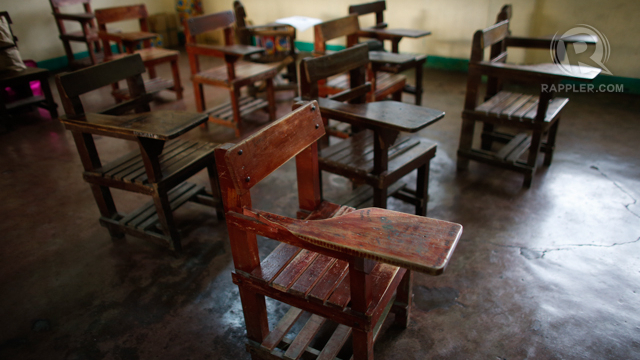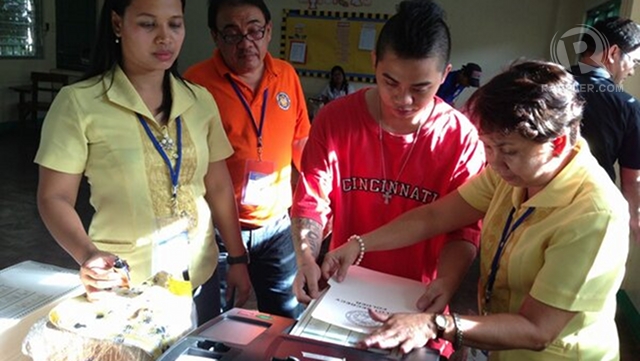SUMMARY
This is AI generated summarization, which may have errors. For context, always refer to the full article.

MANILA, Philippines (UPDATED) – Is this, as the poll body claims, a preview of May 13?
If the Commission on Elections (Comelec) is to be believed, the mock polls on Saturday, February 2, showed an election scenario that runs smoothly, is interrupted by few glitches, but suffers from low public interest.
Comelec Chair Sixto Brillantes Jr saw the glitches first-hand. Brillantes opened the mock polls at the University of the Philippines Integrated School (UPIS), only for the ballot-counting machine to reject the first 3 ballots. The Comelec replaced this with a “contingency” precinct count optical scan (PCOS) machine, and Brillantes had a ready explanation.
“Nagpahinga ito nang tatlong taon, o dalawang taon. So medyo papainitin mo lang nang konti,” Brillantes said in a press conference at another polling area, Ponciano Bernardo High School in Bagong Lipunan ng Crame. (This hibernated for 3 years or two years. So we would need to warm this up a bit.)

The glitches at UPIS, however, lasted for only around an hour. The next few hours in the school went smoothly, as did the mock elections in Crame.
In the provinces, the Comelec “did not receive adverse reports,” Brillantes said on Saturday morning. “Tingin naman namin walang problema talaga eh,” he explained. (We think there’s really no problem.)
Faster process?
During the mock polls, the Comelec not only tested PCOS machines, but also new measures to speed up the voting process.
One of these is the Comelec’s decision to remove the printing of thumbmarks. Brillantes said the Comelec wanted speed – but, as he claimed, not at the expense of security. He said fraudulent voters mess with thumbmarks anyway.
“Based on past experiences, the thumbmark is not effective. Those who are going to cheat will not put their legitimate thumbmark. They’ll either smudge it or use another finger,” Brillantes said.
In earlier interviews, Brillantes said that by doing away with thumbmark-printing, voters wouldn’t have to return to the board of election inspectors after inserting their ballots in the PCOS machine. All they have to do, for 2013, is have their fingers marked with indelible ink and head out of the precinct.
He said another Comelec move – the shortening of the ballot due to the unprecedented party-list purge – could lead to speedier voting.
But did these moves speed up processes, in the first place?
Rappler monitored the time that the first 40 voters spent in the Crame precinct. Based on our own calculation, it took each voter an average of 9.94 minutes to vote, or close to 10 minutes.
At least 75 people have voted in Crame as of posting time.
The experience was different in Cagayan de Oro, with voters taking an average of 5 minutes to vote on Saturday, based on Rappler’s estimates.
In its study on the 2010 elections, the Carter Center said it took around 8 minutes for a voter to fill out the ballot. This is on top of the 20 seconds it would take for a voter to approach the PCOS machine, drop his or her ballot, and leave the precinct. (Read the Carter report below.)
In a separate interview, Comelec spokesman James Jimenez said the Comelec also aims to speed up the transmission of election results.
“It’s in how you transmit and report the results that you can make gains in terms of time. And yes, we think we will be very quick,” Jimenez said.
In the evening, however, various precincts encountered delays in transmitting results to designated servers. Election officers attributed this to bad signal.
Poor turnout
The other, perhaps bigger, problem that hounded the mock polls is the poor turnout. (More in the slide show below)
In Crame, the Comelec expected up to 757 voters. Up to around 2 pm, the voter turnout in the area was only at 46, or around 6% of the expected number.
That’s only 6 persons more than the staff and volunteers at the precinct – 3 teachers serving as election inspectors, 7 volunteers from the National Movement for Free Elections, and 30 from the Parish Pastoral Council for Responsible Voting (PPCRV) who joined the mock elections.
The number of voters only rose to 75 afterwards, particularly when a vehicle commissioned by a village official brought people to the precinct.
Hakots – or voters brought en masse to polling areas, usually to favor certain candidates – proliferate during elections. A similar thing usually happens: a local official transports them to polling precincts to vote for certain candidates, in exchange for food or money.
At UPIS, 158 voters – or 17.9% of the expected number – trooped to the mock elections. The Comelec initially expected 882 voters.
“It is reflective of the culture we have as voters — there’s very little interest that our votes matter,” said PPCRV’s Peter Abejuela, who described the turnout in his area, Cagayan de Oro, as low.
Speaking to Rappler, Comelec Commissioner Lucenito Tagle said the poll body was confident up to 20% of registered voters would show up by 7 pm.
The mock elections, in any case, reflect two things: the Comelec’s preparations and the public’s possibly waning interest in mid-term elections. – With reports from Ara Hamor, Rucha Lim, and Raisa Serafica/Rappler.com
Add a comment
How does this make you feel?
There are no comments yet. Add your comment to start the conversation.